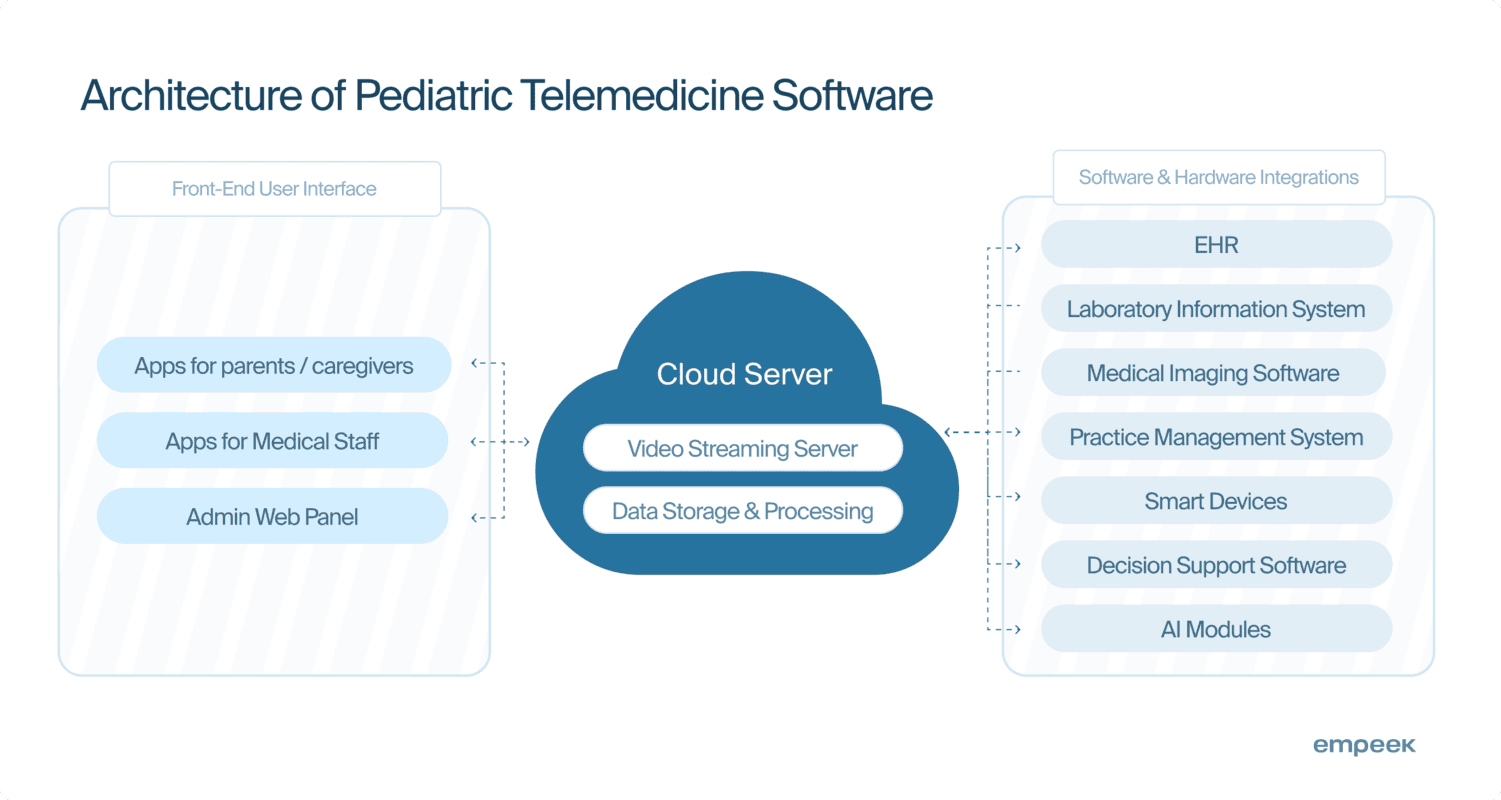Healthcare is undergoing a digital revolution, and pediatric telemedicine is an evident example of the shift. Telemedicine pediatrics harnesses the power of technology to provide high-quality medical care to children and their parents without geographic barriers. Its popularity is soaring, with projections estimating a $149 billion market by 2030.
Pediatric telemedicine stands out due to its tailored approach to children’s healthcare needs. The system architecture is designed specifically to accommodate the unique requirements of the pediatric patient and offer specialized functionalities that support their care. This includes providing convenient access to medical consultations, which can be especially beneficial for chronic illness management, routine check-ups, or when specialist care is required but not available locally.
This comprehensive overview provides a deep dive into pediatric telemedicine, including its software architecture, benefits, challenges, and essential integrations. Learn how these systems integrate with traditional healthcare, expanding its capabilities and reach.
What is Pediatric Telemedicine?
Pediatric telemedicine is a specialized branch of telehealth focused on delivering medical care to children through digital platforms. It enables healthcare providers to diagnose, treat, and monitor young patients remotely through video conferencing, mobile apps, and other digital communication tools.
This approach is particularly valuable in addressing the healthcare needs of children who require specialized care that is not available in their area. By bridging geographical barriers, pediatric telemedicine ensures that children receive timely medical attention without long-distance travel or prolonged waiting times.
Hospitals integrate telemedicine to offer follow-up care and chronic disease management that ensure consistent and comprehensive medical services for children. It is also used in emergencies to provide quick consultations with specialists, improving the response time and outcomes for critical pediatric cases.
Besides, pediatric telemedicine is popular in rural and underserved areas where access to pediatric specialists is limited. Schools and daycare centers also employ telemedicine services to manage minor health issues and chronic conditions, reducing absenteeism and ensuring continuous care.

Related article: Telemedicine App Development: How to Start a Telemedicine Business
Architecture of Pediatrics Telehealth Software
To implement pediatrics telehealth software, you must integrate multiple components into a single healthcare delivery system.
The architecture of pediatric telehealth software typically revolves around a central cloud server, which acts as the hub for various applications and data processing functions. This central server hosts video streaming services, essential for real-time consultations between medical staff and patients. It also manages data storage and processing that ensures all medical records and interactions are securely logged and accessible.
Key elements of the architecture include:
| Apps for Parents | These applications enable easy communication and data sharing between healthcare providers and families. Parents can use their app to schedule appointments, access their child’s medical records, and communicate with doctors. |
| Apps for Medical Staff | Dedicated apps for medical staff offer specialized functionalities to support their professional duties. Doctors can conduct virtual consultations, review patient data, and manage treatment plans. |
| Admin Web Panel | It allows administrators and hospital supervisors to manage the telemedicine platform, including user accounts, appointment schedules, system settings, and data analytics. |
| Integrated Healthcare Software and Hardware | Integrations may include electronic health records (EHR), practice management systems, medical imaging software, and laboratory information systems. Smart connected devices, like wearable health monitors, further enhance the platform by providing real-time health data. |
The diagram illustrates how these components interact through the cloud server, enabling telemedicine companies to offer high-quality healthcare services tailored to the needs of end-users and healthcare organizations.

Due to the complexity of pediatric telemedicine integration, the implementation requires the help of experienced partners, like Empeek, to ensure the system is robust, secure, and user-friendly. Learn more about the telemedicine development and integration services we provide.
Examples of Successful Telemedicine Pediatrics Implementation
Pediatric telemedicine has seen numerous successful implementations across various healthcare settings, enhancing access to specialized care for children. These examples show how telemedicine can be effective in pediatric care and illustrate the different ways you can use technology to meet the specific needs of young patients.
Children’s Health System of Texas
Children’s Health System of Texas it integrated telemedicine into their services. The health system provides remote consultations that allow pediatric specialists to offer their expertise to children in rural and underserved areas. This initiative has significantly reduced the need for long-distance travel and hospital visits, improving care accessibility and convenience for families.
This health system experienced a dramatic increase in telehealth visits during the COVID-19 pandemic, rising from 2,033 visits between March and October 2019 to 54,276 visits in the same period in 2020, an increase of over 2,500%. This surge illustrates the system’s ability to meet increased demand and maintain high-quality care through telemedicine.
Nemours Children’s Health System
Nemours has implemented a comprehensive telehealth program that has enrolled more than 17,000 patients. Their telemedicine services are proven to improve patient engagement and satisfaction, especially for chronic conditions such as asthma and diabetes, where continuous monitoring and timely intervention are critical.
Children’s Mercy Kansas City
They offer telehealth services across multiple specialties, including pediatric cardiology and neonatology. The telehealth initiative at Children’s Mercy has facilitated faster diagnosis and treatment, particularly in critical care scenarios where immediate specialist input is required.
Their REACT program for epilepsy care connects specialists with primary care providers in rural areas, improving access and outcomes for children with epilepsy. Additionally, their school-based telemedicine program for asthma has shown promising results in improving asthma control, reducing emergency visits, and decreasing school absences for students with asthma.
These examples underscore the transformative potential of pediatric telemedicine. Thanks to technology, healthcare providers can overcome geographic barriers, offer timely and specialized care, and improve the overall health outcomes for children. These successes highlight the importance of integrating telemedicine into pediatric care frameworks and demonstrate the benefits for patients, families, and healthcare systems.
Benefits of Telemedicine Pediatrics
The implementation of telemedicine in pediatrics brings numerous advantages, enhancing the quality, accessibility, and efficiency of healthcare services for young patients. It also provides convenience for families, reducing the need for travel and minimizing disruption to daily routines. Let’s delve into these benefits and the specific ways telemedicine transforms pediatric care.

Improved Access to Specialized Care
One of the most significant benefits of telemedicine for pediatrics is improved access to specialized care. Many children live in rural or underserved areas where access to pediatric specialists is limited. Telemedicine bridges this gap by connecting these children with specialists via virtual consultations. More than 17 million children in the US live over an hour’s drive from a regional pediatric hospital, and telemedicine can ensure they receive timely care without the need for long-distance travel.
Cost and Time Savings
Telemedicine significantly reduces the costs associated with healthcare. Families can conduct consultations from home, saving on travel expenses and reducing the need to take time off work. Studies have shown telemedicine can save families an average of $50 per visit in travel costs and up to 51 minutes in waiting and visit time. This reduction in costs and time is especially beneficial for managing chronic conditions that require regular follow-ups.
Read: How Telehealth Cuts Cost and Improves Health Outcomes
Enhanced Continuity of Care
Telemedicine improves continuity of care for children with chronic conditions or those requiring ongoing medical attention. Through regular virtual check-ups, healthcare providers can monitor patients’ progress and make timely adjustments to treatment plans. Continuous monitoring helps manage conditions more effectively and reduces the likelihood of complications.
Reduced Emergency Visits
By providing timely medical advice and intervention, pediatrics telemedicine can reduce unnecessary emergency room visits. For instance, virtual consultations can help triage patients by assessing their medical needs remotely. This ensures that only those requiring urgent care visit the hospital, thereby reducing overcrowding in emergency departments. Telemedicine in emergency rooms has been shown to reduce patient length of stay by 31% and cut waiting times. Additionally, a telemedicine service in Rochester, New York, demonstrated a 22% reduction in emergency department visits among children with access to telemedicine.
Increased Patient and Family Satisfaction
Telemedicine often leads to higher patient and family satisfaction due to its convenience and efficiency. Families appreciate the ability to receive medical care without the stress of travel and long waiting times. A recent study showed that 97.9% of caregivers and patients participating in telemedicine visits reported high satisfaction with the provider, compared with 83.9% for in-person visits.
Pediatric telemedicine offers numerous benefits, including improved access to specialized care, cost and time savings, enhanced continuity of care, reduced emergency visits, and increased patient satisfaction. This digital transformation makes healthcare more efficient and equitable, ensuring that all children receive the care they need, regardless of their geographic location.
Acute Health Conditions That Require Immediate Help
Children often suffer from acute illnesses that require prompt medical attention. For example, conditions such as asthma attacks, severe allergic reactions, or acute infections demand immediate intervention.
Acute conditions are a significant cause of pediatric emergency department visits, with about 30 million pediatric ED visits occurring annually in the U.S., representing 20% of all ED visits. Pediatric telemedicine can provide quick access to healthcare providers, allowing for immediate evaluation and management, which can be critical in preventing health complications.
Easy Spread of Infectious Diseases
Children are highly susceptible to infectious diseases, which can spread rapidly in communal settings like schools and daycare centers. Pediatric telemedicine can play a crucial role in managing and controlling outbreaks by enabling remote consultations. This reduces the need for in-person visits, thereby limiting exposure and spread. For example, during the COVID-19 pandemic, telemedicine proved invaluable in providing care while minimizing the risk of infection transmission.
Chronic Disease Management
Chronic conditions like diabetes, asthma, and epilepsy are prevalent among children and require consistent management and follow-ups. Telemedicine plays a vital role in such care by enabling continuous monitoring and frequent virtual check-ins.
Telemedicine for chronic disease management has shown significant benefits in improving health outcomes and reducing hospital visits. Remote patient monitoring collects health data like blood glucose levels in diabetic children, which allows pediatricians to review it and quickly adjust treatment plans online.
Mental, Behavioral, and Developmental Disorders
Mental health concerns, including anxiety, depression, and behavioral disorders, are increasingly prevalent among children and adolescents. 1 in 6 children aged 2-8 in the US were diagnosed with mental, behavioral, or developmental disorders.
Virtual therapy sessions for children and caregivers can help address these issues effectively, especially in areas with a shortage of mental health providers. A study indicated that during the pandemic, 39% of telehealth outpatient visits were primarily for mental health or substance use, highlighting the critical role of telemedicine in meeting this growing need.
Your next read: Telehealth Use for Mental Health Issues.
Unequal Access to Healthcare
Geographical and socio-economic disparities often limit access to pediatric healthcare. Many children in rural or underserved areas struggle to access specialized medical care. Telemedicine bridges this gap by enabling remote consultations with specialists.
Studies show telemedicine has been particularly effective in reducing healthcare disparities and providing equitable care to children across different regions. For example, during the COVID-19 pandemic, rural hospitals in Michigan implemented telehealth measures that resulted in over 14,000 virtual visits in a six-week period, significantly improving access to care for rural populations.
Pediatric telemedicine is a powerful tool in addressing the unique challenges of pediatric healthcare. By offering immediate help for acute illnesses, managing infectious diseases, supporting chronic disease management, providing mental health services, and bridging healthcare access disparities, telemedicine ensures that children receive timely and effective care.
9 Software Solutions to Integrate with Telemedicine Pediatrics for Ultimate Efficiency
To maximize the benefits of pediatric urgent care telemedicine, you should integrate it with other software solutions that have complementary functionality. These integrations ensure comprehensive, efficient, and seamless healthcare delivery by enhancing communication, data management, and patient care. Below are the top software solutions to integrate with telemedicine pediatrics.
1. Electronic Health Records (EHR) Systems
Electronic Health Records (EHR) systems are digital versions of patients’ paper charts. They provide real-time, patient-centered information, enabling authorized users to access a patient’s medical data instantly and securely. EHRs support a range of functions, including managing patient demographics, tracking diagnoses and treatments, streamlining clinical workflows, and facilitating communication among healthcare providers. For more information on the importance and integration of EHR systems in telehealth, read this detailed article.
Popular EHR Systems:
- Epic
- Cerner
- Allscripts
- eClinicalWorks
2. Practice Management Software (PMS)
Practice Management Software helps manage daily operations such as scheduling appointments, billing, and other administrative tasks. PMS enhances operational efficiency by automating routine processes, allowing healthcare providers to focus more on patient care.
Popular PMS Solutions:
- Kareo
- athenahealth
- NextGen Healthcare
- Greenway Health
3. Remote Patient Monitoring (RPM) Devices
Remote Patient Monitoring tools allow healthcare providers to monitor patients outside the traditional clinical settings, such as at home. RPM devices collect a wide range of health data from the point of care, including weight, blood pressure, blood sugar, and electrocardiograms.
Popular RPM Tools:
- Philips Remote Patient Monitoring
- Health Recovery Solutions
- Medtronic Care Management Services
- BioTelemetry
4. Pharmacy Management Software
Pharmacy management software streamlines pharmacy operations by managing medication inventory, processing prescriptions, and handling billing. It helps pharmacies ensure accurate dispensing, monitor stock levels, and improve customer service.
Popular Pharmacy Management Software:
- PioneerRX
- McKesson EnterpriseRx
- QS/1 Pharmacy Management
- Liberty Software
- PrimeRx
5. Medical Imaging Software
Medical imaging software is used to create, store, and analyze human body images for clinical purposes. This software is essential for diagnosing and monitoring various medical conditions by providing detailed visuals, such as X-rays, MRIs, and CT scans.
Popular Medical Imaging Software:
- GE Healthcare Centricity
- Philips IntelliSpace
- Siemens Syngo
- Agfa HealthCare Enterprise Imaging
- FujiFilm Synapse
6. Medical Billing Software
Medical Billing Software simplifies billing by automating claims submission, tracking payments, and managing patient billing. It ensures accurate and timely reimbursement for services rendered.
Popular Medical Billing Software:
- AdvancedMD
- DrChrono
- Kareo Billing
- PrognoCIS
7. Health Information Exchange (HIE) Systems
Electronic Health Information Exchange (HIE) enables healthcare professionals, such as doctors, nurses, and pharmacists, and patients, to access and securely share essential medical information electronically. The timely sharing of critical patient data enhances decision-making at the point of care, helps prevent readmissions, avoids medication errors, improves diagnoses, and reduces duplicate testing.
Popular HIE Systems:
- Cerner Health Information Exchange
- Epic Care Everywhere
- Allscripts dbMotion
- eClinicalWorks eEHX
8. Clinical Decision Support Systems (CDSS)
Clinical Decision Support Systems provide healthcare professionals with tailored clinical knowledge and patient information when they need it, which helps improve patient care. CDSS tools aid in decision-making by integrating clinical guidelines and patient data.
Popular CDSS Solutions:
- UpToDate
- IBM Watson Health
- Elsevier ClinicalKey
- Zynx Health
9. Laboratory Information Systems
Laboratory Information Systems (LIS) manage laboratory data and workflows. They support sample tracking, data entry, and test result management, which ensures efficient and accurate laboratory operations. LIS systems help streamline lab processes, improve data accuracy, and enhance communication between lab personnel and healthcare providers.
Popular Laboratory Information Systems:
- Cerner Millennium
- Sunquest Information Systems
- Epic Beaker
- Orchard Harvest LIS
- McKesson Lab Analytics
Integrating telemedicine pediatrics with these comprehensive software solutions ensures an effective and holistic approach to pediatric care. These integrations enable healthcare providers to deliver high-quality care by enhancing data management, improving patient engagement, and streamlining administrative processes.
Empeek’s Pediatric Telehealth Software Development and Integration Services
At Empeek, we specialize in creating and integrating advanced telehealth solutions tailored for pediatric healthcare. Our services encompass custom telehealth software development, integration with Electronic Health Records (EHR) systems, and the implementation of remote patient monitoring tools and patient portals.
One of our projects involved developing a HIPAA-compliant EHR and telemedicine platform for a US-based hospital. This comprehensive solution replaced the hospital’s legacy software with a modern digital platform, significantly improving data management and accessibility for healthcare providers. The platform included automated billing, appointment scheduling, and secure communication features, facilitating better patient engagement and operational efficiency. Discover this and other case studies.
Conclusion
Pediatric telemedicine is a big improvement in children’s healthcare, making medical consultations more accessible, convenient, and efficient. It ensures that every child can receive the best possible medical care, no matter where they live.
The system architecture of pediatric telemedicine is robust, integrating various components such as Electronic Health Records (EHR), remote patient monitoring tools, and patient portals to streamline workflow and enhance the quality of care. If you need help with pediatric telemedicine development or integration, contact Empeek for consulting and project estimates.








